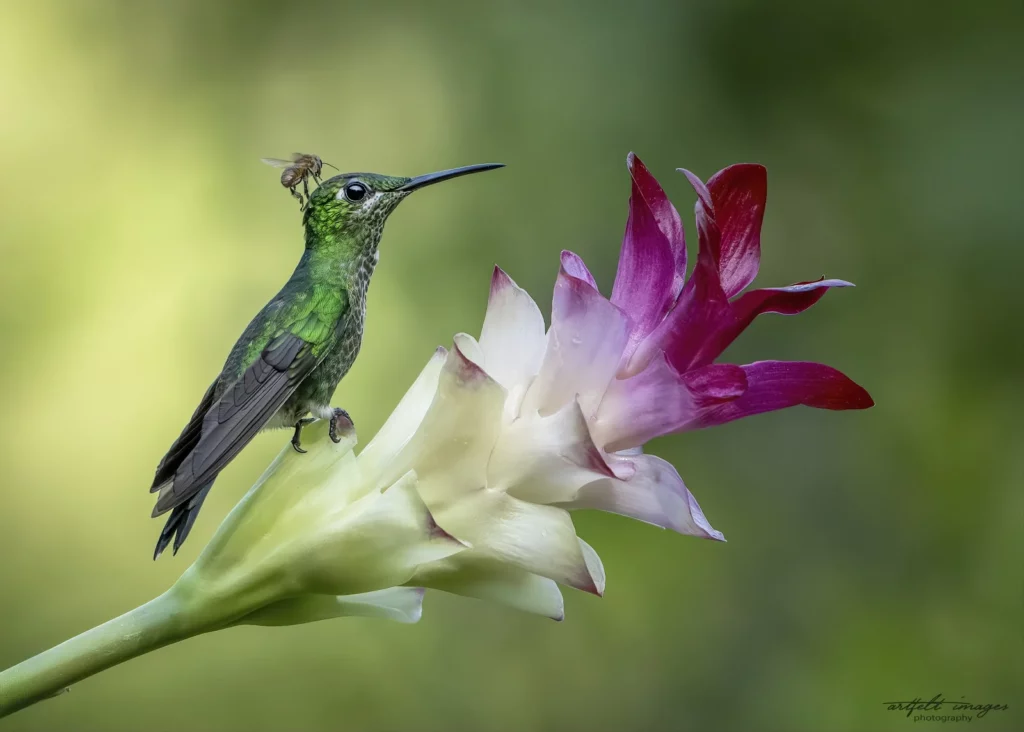Green-Crowned Brilliant
Green-Crowned Brilliant Hummingbird is a medium-sized hummingbird with a vibrant green body, black bill, and a white spot behind the eye. Males are more uniformly green, while females have speckled underparts. The best places to see it are cloud forests and montane rainforests in Costa Rica, particularly in reserves like Monteverde and areas with abundant…

Heliodoxa jacula
Scientific Name
Trochilidae (Hummingbirds)
Family
Apodiformes
Order
Heliodoxa jacula jacula
Subspecies. Central America, including Costa Rica
Heliodoxa jacula henryi
Subspecies. Western part of Panama and southern Costa Rica
Range and Habitat
Geographic Range
Found from Costa Rica to western Panama and in northwestern South America.
Migratory Patterns
Non-migratory.
Preferred Habitat
Prefers humid and wet forests, especially at the edges, as well as forest clearings.
Altitude Range
Typically found between 500 and 2,000 meters (1,600 to 6,600 feet) in elevation.
Costa Rica Habitat
In Costa Rica, Green-Crowned Brilliant is commonly seen in the Caribbean lowlands and foothills, as well as the Pacific slope.
Conservation Status
Least Concern
Conservation Status
Population Status
Stable and classified as Least Concern due to its wide range and adaptability to secondary forests.
Deforestation and habitat fragmentation. Climate change affecting flowering plants.
Conservation efforts
Protected in many reserves and national parks, particularly in Costa Rica, where its habitat overlaps with protected areas such as Monteverde and Braulio Carrillo National Park.
Primary Threats
Deforestation and habitat fragmentation. Climate change affecting flowering plants.
Identification
Green-Crowned Brilliant
Rarity Level:
CommonBest Viewing Times:
Early Morning (Dawn - 8 AM), Afternoon (2 PM - 5 PM)
Size
Length 12-13 cm (4.7-5.1 inches), Weight 9-10 grams
Plumage
- Males have an iridescent green body with a slightly bluish tinge on the throat, and a glittering crown.
- Females are also green, but their underparts are more mottled white with green specks.
Distinctive Features
- A straight black bill.
- White spots behind the eyes.
Sexual Dimorphism
Males are more uniformly iridescent, while females show more contrast with their pale, speckled underparts.
Diet and Feeding Behavior
Primary Diet
- Nectar from a wide range of flowers, particularly those with tubular shapes. Also feeds on small insects and spiders for protein.
Foraging Techniques
- Hovers in front of flowers to feed on nectar using its long, slender bill. Occasionally perches to feed, especially in areas with abundant flowers.
Feeding Times
- Most active during early morning and late afternoon.
Behavior Patterns
Green-Crowned Brilliant
Lorem ipsum dolor sit amet, consectetur adipiscing elit, sed do eiusmod tempor incididunt ut labore et dolore magna aliqua.
Social Structure
Generally solitary, though it may share feeding territories with other hummingbird species.
Song and Vocalization
High-pitched, repetitive chirps and squeaks. Often heard while feeding.
Courtship and Mating Ritual
Males perform aerial displays, darting back and forth to attract females.
Territoriality
Males are highly territorial and will chase other hummingbirds and small birds away from their feeding grounds.
Birdwatching Tips
Best Locations
- Monteverde Cloud Forest Reserve
- Braulio Carrillo National Park
- La Paz Waterfall Gardens, where feeders attract many individuals.

Best Time of the Year
Year-round sightings are possible, but the rainy season may offer more active feeding behavior.
Common Behavior
Look for them near flowering shrubs, especially where there are feeders. They tend to hover at eye level.
Recommended Gear
Binoculars with fast focus for catching their rapid movements, and a camera with a fast shutter speed for photos.
Breeding and Nesting Behavior
Breeding Season
Typically year-round in Costa Rica, with peaks during the rainy season (May to October).
Nesting Sites
Small cup-shaped nests made of plant fibers, moss, and spider webs. Often built on thin branches or under large leaves.
Clutch Size
Usually 2 eggs.
Incubation Period
{acf_breeding_and_nesting_incubation_period}
Parental Care
The female alone incubates the eggs and feeds the chicks after hatching.
Did You Know?
How do I identify this bird?
Look for a medium-sized hummingbird with a vibrant green body, black bill, and a white spot behind the eye. Males are more uniformly green, while females have speckled underparts.
Where is the best place to see it?
Cloud forests and montane rainforests in Costa Rica, particularly in reserves like Monteverde and areas with abundant flowers or feeders.
Is this bird endangered?
No, it is listed as Least Concern due to its wide distribution and stable population.
Interesting Behaviors
Known for its aggressive defense of nectar sources, often chasing away larger birds.
Hummingbirds can beat their wings up to 80 times per second, which helps them hover while feeding.Cultural Significance
Hummingbirds, including the Green-crowned Brilliant, are revered in many Central American cultures as symbols of vitality and energy.
Tricky identification
Both immature males and females display a light orange patch of feathers under the bill making identification tricky. The female always displays speckles, though that is the key field mark. As this species ages, the orange patches fade.